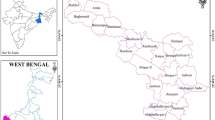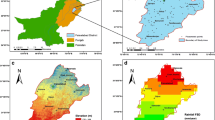Abstract
The present research aims to derive the intrinsic vulnerability of groundwater against contamination using the GIS platform. The study applies DRASTIC model for Ahmedabad district in Gujarat, India. The model uses parameters like depth, recharge, aquifer, soil, topography, vadose zone and hydraulic conductivity, which depict the hydrogeology of the area. The research demonstrates that northern part of district with 46.4% of area is under low vulnerability, the central and southern parts with 48.4% of the area are under moderate vulnerability, while 5.2% of area in the south-east of district is under high vulnerability. It is observed from the study that lower vulnerability in northern part may be mostly due to the greater depth of vadose zone, deeper water tables and alluvial aquifer system with minor clay lenses. The moderate and high vulnerability in central and southern parts of study area may be due to lesser depth to water tables, smaller vadose zone depths, unconfined to semi-confined alluvial aquifer system and greater amount of recharge due to irrigation practices. Further, the map removal and single-parameter sensitivity analysis indicate that groundwater vulnerability index has higher influence of vadose zone, recharge, depth and aquifer parameters for the given study area. The research also contributes to validating the existence of higher concentrations of contaminants/indicators like electrical conductivity, chloride, total dissolved solids, sulphate, nitrate, calcium, sodium and magnesium with respect to groundwater vulnerability status in the study area. The contaminants/indicators exceeding the prescribed limits for drinking water as per Indian Standard 10500 (1991) were mostly found in areas under moderate and high vulnerability. Finally, the research successfully delineates the groundwater vulnerability in the region which can aid land-use policies and norms for activities related to recharge and seepage with respect to existing status of groundwater vulnerability and its quality.















Similar content being viewed by others

References
Aller L, Bennett T, Lehr JH, Petty RJ, Hackett G (1985) DRASTIC: a standardized system for evaluating ground water pollution potential using hydrogeologic settings. U.S. EPA, Chicago
Aller L, Bennett T, Lehr JH, Petty RJ, Hackett G (1987) DRASTIC: a standardized system for evaluating ground water pollution potential using hydrogeologic settings. U.S. EPA, Chicago
Arora PK, Rawat SN, Chhabra SS, Prakash S (1996) Evaluation of recharge to groundwater due to applied irrigation under different crops in Uttar Pradesh using isotope tracer technique—a field study. In: Singh VP, Kumar B (Eds) Subsurface-water hydrology, vol 16. Kluwer Academic Publishers, Dordrecht, pp 119–130
Babiker IS, Mohamed MA, Tetsuya H, Kikuo K (2005) A GIS-based DRASTIC model for assessing aquifer vulnerability in Kakamigahara Heights, Gifu Prefecture, central Japan. Sci Total Environ 345(1–3):127–140
Bouwer H (1978) Groundwater hydrology. McGraw-Hill Book Company, New York
Brady NC (1995) Nature and properties of soils book. Prentice Hall of India Pvt. Ltd, New Delhi
Central Ground Water Board (2014) Dynamic groundwater resources of india. Ministry of Water Resources, Faridabad
Chakraborty S, Paul P, Sikdar P (2007) Assessing aquifer vulnerability to arsenic pollution using DRASTIC and GIS of North Bengal. J Spat Hydrol 7(1):101–121
Chandrashekar H, Ranganna G, Nataraju C (2000) Assessment of groundwater pollution potential through remote sensing and GIS technique a case study for Anekal taluk, Bangalore urban district, India. Int Arch Photogramm Remote Sens 33(Part B7):258–263
Chitsazan M, Akhtari Y (2009) A GIS-based DRASTIC model for assessing aquifer vulnerability in Kherran Plain, Khuzestan, Iran. Water Resour Manag 23:1137–1155
Department of Agriculture and Cooperation (2008) Agriculture contingency plan for district. Department of Agriculture and Cooperation, Ministry of Agriculture, Government of India, Ahmedabad
Environmental Planning Collaborative (1998) Proposal for Sabarmati riverfront development, Ahmedabad. Environmental Planning Collaborative, Ahmedabad
Esteller MV, Rodríguez R, Cardona A, Padilla-Sánchez L (2012) Evaluation of hydrochemical changes due to intensive aquifer exploitation case studies from Mexico. Environ Monit Assess 184:5725–5741
Foster S, Hirata R, Gomes D, D’Elia M, Paris M (2002) Groundwater quality protection. Washington, DC, The World Bank
Gogu RC, Dassargues A (2000a) Sensitivity analysis for the EPIK method of vulnerability assessment in a small karstic aquifer, southern Belgium. Hydrogeol J 8:337–345
Gogu R, Dassargues A (2000b) Current trends and future challenges in groundwater vulnerability assessment using overlay and index methods. Environ Geol 39(6):549–559
Gupte PR (2011) Ahmedabad–Gandhinagar Twin City, Gujarat. In: Central Ground Water Board, Ground water scenario in major cities of India. Central Ground Water Board, Ministry of Water Resources, Government of India, Faridabad, pp 7–17
Jamrah A, Al-Futaisi A, Rajmohan N, Al-Yaroubi Saif (2008) Assessment of groundwater vulnerability in the coastal region of Oman using DRASTIC index method GIS environment. Environ Monit Assess 147:125–138
Jamshidzadeh Z, Mirbagheri SA (2011) Evaluation of groundwater quantity and quality in the Kashan Basin, Central Iran. Desalination 270(1–3):23–30
Kaliraj S, Chandrasekar N, Simon Peter T, Selvakumar S, Magesh NS (2015) Mapping of coastal aquifer vulnerable zone in the south west coast of Kanyakumari, South India, using GIS-based DRASTIC model. Environ Monit Assess 187:4073
Kaur R, Rosin KG (2009) Ground water vulnerability assessment—challenges and opportunities. 5th asian regional conf. of INCID, central groundwater board, ministry of water resources. New Delhi, India
Khemiri S, Khnissi A, Alaya MB, Saidi S, Zargouni F (2013) Using GIS for the comparison of intrinsic parametric methods assessment of groundwater vulnerability to pollution in scenarios of semi arid climate. The case of Foussana groundwater in the central of Tunisia. J Water Resour Prot 5:835–845
Lodwick WA, Monson W, Svoboda L (1990) Attribute error and sensitivity analysis of map operations in geographical information systems: suitability analysis. Int J Geogr Inf Syst 4(4):413–428
Margat J, van der Gun J (2013) Groundwater around the World: a geographic synopsis. CRC Press, Leiden
Masoud MH, Osta MM (2016) Evaluation of groundwater vulnerability in El-Bahariya Oasis, Western Desert, Egypt. J Earth Syst Sci 125(6):1139–1155
Ministry of Urban Development (2011) Report on Indian urban infrastructure and services. Ministry of Urban Development, Government of India, New Delhi
Ministry of Water Resources (2009) Groundwater estimation methodology. Ministry of Water Resources, Government of India, New Delhi
Napolitano P, Fabbri AG (1996) Single-parameter sensitivity analysis for aquifer vulnerability assessment using DRASTIC and SINTACS. HydroGIS 96 Appl Geogr Inf Syst Hydrol Water Resour 235:559–566
National Research Council (1993) Ground water vulnerability assessment: predicting relative contamination potential under conditions of uncertainty. National Academy Press, Washington, DC
Piscopo G (2001) Groundwater vulnerability map explanatory notes Castlereagh catchment. Centre for natural resources, NSW department of land and water conservation, Parramatta
Rahman A (2008) A GIS based DRASTIC model for assessing groundwater vulnerability in shallow aquifer in Aligarh, India. Appl Geog 28(1):32–53
Rao SM, Mamatha P (2004) Water quality in sustainable water management. Curr Sci 87(7):942–947
Rundquist DC, Peters AJ, Di L, Rodekohr DA, Ehrman RL, Murray G (1991) Statewide groundwater-vulnerability assessment in nebraska using the drastic/GIS model. Geocarto Int 6(2):51–58
Rupert MG (1999) Improvements to the DRASTIC ground-water vulnerability mapping method. United States Geological Survey, Washington, DC
Secunda S, Collin ML, Melloul AJ (1998) Groundwater vulnerability assessment using composite model combining DRASTIC with extensive agricultural land use in Israel’s Sharon region. J Environ Manag 54(1):39–57
Shamsuddin S (2000) A study of groundwater pollution vulnerability using DRASTIC/GIS, West Bengal, India. J Environ Hydrol 8:1–9
Shirazi SM, Imran HM, Akib S, Yusop Z, Harun ZB (2013) Groundwater vulnerability assessment in the Melaka state of Malaysia using DRASTIC and GIS techniques. Environ Earth Sci 70:2293–2304
Sobowale A, Ramalan AA, Mudiare OJ, Oyebode MA (2014) Groundwater recharge studies in irrigated lands in Nigeria: implications for basin sustainability. Sustain Water Qual Ecol 3–4:124–132
UNDP/CGWB (1976) Groundwater surveys in Rajasthan and Gujarat, India, Technical Report. United Nations, New York
Vrba J, Zaporozec A (eds) (1994) Guidebook on mapping groundwater vulnerability. International association of hydrogeologists, vol 16. International Contributions to Hydrogeology, Hannover, Heise
WHO (2003) Sodium in drinking water (Report No. WHO/SDE/WSH/03.04/15). WHO, Geneva
Working Group Report to Planning Commission (2011) Sustainable groundwater management. Working Group Report
Author information
Authors and Affiliations
Corresponding author
Rights and permissions
About this article
Cite this article
Khakhar, M., Ruparelia, J.P. & Vyas, A. Assessing groundwater vulnerability using GIS-based DRASTIC model for Ahmedabad district, India. Environ Earth Sci 76, 440 (2017). https://doi.org/10.1007/s12665-017-6761-z
Received:
Accepted:
Published:
DOI: https://doi.org/10.1007/s12665-017-6761-z



